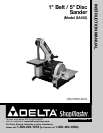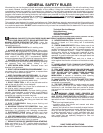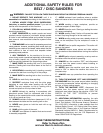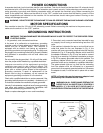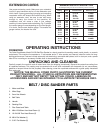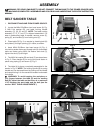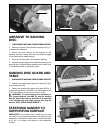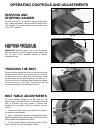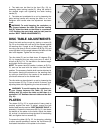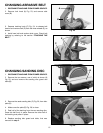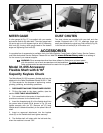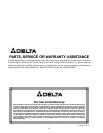
3
ADDITIONAL SAFETY RULES FOR
BELT / DISC SANDERS
WARNING: FAILURE TO FOLLOW THESE RULES MAY RESULT IN SERIOUS PERSONAL INJURY.
SAVE THESE INSTRUCTIONS.
Refer to them often
and use them to instruct others.
1. DO NOT OPERATE THIS MACHINE until it is
assembled and installed according to the instructions.
2. OBTAIN ADVICE FROM YOUR SUPERVISOR,
instructor, or another qualified person if you are not
familiar with the operation of this machine.
3. FOLLOW ALL WIRING CODES and recommended
electrical connections.
4. DUST GENERATED by certain woods and wood
products can be Injurious to your health. always operate
all tools in well-ventilated areas and provide for proper
dust removal. use wood/dust collection systems when
possible.
5. THIS MACHINE can be used for processing wood and
metal products. however, combining both wood dust and
metal filings can create a fire hazard. make certain that the
dust collector is free of wood dust deposits before
processing metal products.
6. ANY TENDENCY for the machine to tip over or
move during certain operations (especially when sanding
long or heavy boards, etc.,) requires that the machine
must be securely fastened to a supporting surface.
7. MAKE SURE the sanding belt runs in the proper
direction. Sanding belt must travel down at the front of
the machine.
8. BE CERTAIN the sanding belt is tracking correctly
to prevent the belt from runnning off of the pulleys.
9. MAKE SURE the sanding belt or disc is not torn or
loose.
10. HOLD the work firmly when sanding.
11. SUPPORT workpiece firmly with the miter gage,
backstop or work table when sanding with the belt.
NOTE: The only exception to this is working with a
curved workpiece on the top wheel of belt.
12. AVOID kickback by sanding in accordance with
directional arrows. Sand on downward side of disc.
Sanding on the upward side could cause the workpiece
to fly up and cause an injury.
13. ALWAYS maintain a maximum clearance of 1/16" or
less between the table and the sanding belt or disc.
14. NEVER wear gloves or hold the work with a rag
when sanding.
15. SAND with the grain of the work.
16. DO NOT sand pieces of material that are too small
to be safely supported.
17. AVOID awkward hand positions where a sudden
slip could cause a hand to move into the sanding belt or
disc.
18. WHEN sanding a large workpiece, provide an
additional support at table height.
19. NEVER force the work. Slowing or stalling the motor
will cause overheating.
20. WHEN sanding metal, friction will cause the metal
to heat. Stop long enough to let the metal cool.
21. WHEN sanding metal never use a steady stream of
water on the workpiece. Dip the workpiece in water to
cool it.
22. DO NOT sand or polish magnesium. This action will
cause a fire hazard.
23. ALWAYS remove scrap pieces and other objects
from the belt and disc tables before turning the machine
“ON.”
24. NEVER perform layout, assembly, or set-up work on
the tables while the sander is operating.
25. ALWAYS turn the machine “OFF” and disconnect
the cord from the power source before installing or
removing accessories.
26. NEVER leave the machine work area when the
power is “ON” or before the machine has come to a
complete stop.
27. ALWAYS wear eye protection when operating the
sander.
28. TURN THE MACHINE “OFF” AND DISCONNECT
THE MACHINE from the power source before installing
or removing accessories, before adjusting or changing
set-ups, or when making repairs.
29 TURN THE MACHINE “OFF”, disconnect the
machine from the power source, and clean the
table/work area before leaving the machine. LOCK THE
SWITCH IN THE “OFF” POSITION to prevent
unauthorized use.
30. ADDITIONAL INFORMATION regarding the safe
and proper operation of this tool is available from the
Power Tool Institute, 1300 Summer Avenue, Cleveland,
OH 44115-2851. Information is also available from the
National Safety Council, 1121 Spring Lake Drive, Itasca,
IL 60143-3201. Please refer to the American National
Standards Institute ANSI 01.1 Safety Requirements for
Woodworking Machines and the U.S. Department of
Labor OSHA 1910.213 Regulations.



